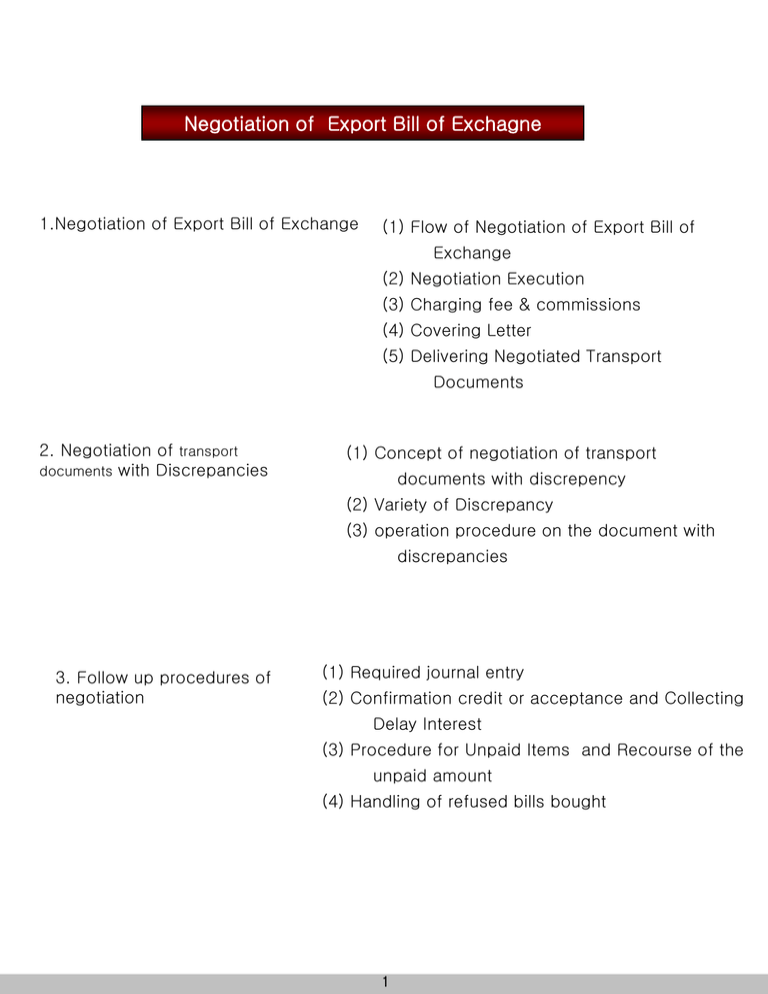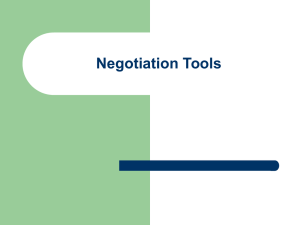Negotiation of Export Bill of Exchagne
advertisement

Negotiation of Export Bill of Exchagne 1.Negotiation of Export Bill of Exchange (1) Flow of Negotiation of Export Bill of Exchange (2) Negotiation Execution (3) Charging fee & commissions (4) Covering Letter (5) Delivering Negotiated Transport Documents 2. Negotiation of transport documents with Discrepancies (1) Concept of negotiation of transport documents with discrepency (2) Variety of Discrepancy (3) operation procedure on the document with discrepancies 3. Follow up procedures of negotiation (1) Required journal entry (2) Confirmation credit or acceptance and Collecting Delay Interest (3) Procedure for Unpaid Items and Recourse of the unpaid amount (4) Handling of refused bills bought 1 1.Negotiation of Export Bill of Exchange (1) Flow of Negotiation of Export Bill of Exchange Accepting Application Document to negotiate Examination of Documents Follow-up Procedures Forwarding and Keeping Documents Negotiation Execution Credit negotiated amount Charging fee and Commission (2) Negotiation Execution Negotiation Execution = Accounting via computation Sight B/E Sight Bills Bought a/c Usance B/E Usance Bills Bought a/c (3) Charging fee & commissions Commissions : Exchange commission, postage and other commissions related to purchasing. Exchange commission means negotiation interest of export bill of exchange collected from client when purchasing export bill of exchange. For example, when bank negotiates export B/E, they immediately pay bill amount to the client but the negotiating bank has to wait considerable amount of time until getting repaid by overseas bank and it collects the interest occurred in the meantime from the client. ※ Charging exchange commission differs from SIGHT L/C to USANCE L/C. Moreover, in SIGHT L/C, interest rate defers from clean negotiation and negotiation without discrepancy . <Fee handling procedure> 1) Charging Exchange Commition - Calculation of exchange commission for negotiating sight export bills ㅇ Clean NEGO : Principal × exchange commission rate corresponding to standard collection period × base rate ㅇ Defect NEGO : Principal × (annual exchange commission rate +1.5%) × standard collection period/360 days × base rate ㅇ Accounting : Credit to the account of interest on sight export bills bought (L/C) - Exchange commission for negotiating usance export bills ㅇ Exchange commission is charged on a quarterly basis for the period ranging from the date of negotiation to maturity. Applied rate: Exchange commission rate per currency/period + additional rate per bill period ㅇ Accounting Item : Credit to the account of interest on usance export bills bought (L/C) 2) Collection of fees for mailing and special delivery service 3) Credit negotiated amount and entry 2 (4) Covering Letter Covering Letter : A document written in order to send t negotiated documents to the overseas bank ◆ Detailed list of Documents on the cover letter : According to conditions required by L/C ◆ Request settlement : print a phrase that demands the other bank for settlement (Example) ◆ Special Instruction on the cover letter (Example) ▶ Write details of the defect in case of warranted purchase Late shipment and credit expired. ▶ Write delivery related matters such as ‘1set of transport documents should be sent to a third-party person’ We have forwarded 1 set of transport documents to ABC Co. New York in accordance with the credit terms. ▶ If there is a special instruction about remittance on L/C such as Agent Commission We have remitted the agent commission for U$1,000 to ××× Co. in accordance with above L/C terms ▶ If it is requested to be remitted on the maturity date as Shipper's Usance Pay us the proceeds valued on due date. ▶ If the Banker’s usance with Discount Charge on Buyer was purchased at sight We have negotiated the draft(s) on a sight basis as discount charges are for buyer's account, please pay us the face amount of the draft(s) at sight ▶ If B/E has been purchased the day after L/C expiry date because it was bank’s day off The documents were presented within the time limits extended in accordance with article 44(a) of the Uniform Customs and Practice for Documentary Credits, 2007 revision, ICC Publication No.600 ◆ Issuing Reimbursement Draft - How to collect negotiated amount When L/C designates a reimbursement bank, reimbursement drafts or reimbursement claim cable(MT 472) has to be formed and sent in order to collect negotiated amount. ◆ Collecting Negotiation amount - Negotiation amount for USD export bill of exchange has to be requested to be remitted to KEB’s account of JP Morgan Chase, New York. - Exception ㅇ Negotiation of L/C that has been issued by overseas branch of our bank. ㅇ L/C issued by a correspondent bank with Their Account at KEB which indicates that money will be debited from the account ㅇ negotiation of L/C that has to be claimed for a re-negotiation to other banks ㅇ negotiation of L/C that cannot be concentrated to JP Morgan Chase, New York, because of (5) Delivering Transport Documents other special transactions. ◆ Delivery Time (수출입업무 취급지침 제2-6조). -You must ask for Reimbursement’ if there is no day phrase prohibits negotiating export - Must be‘T/T sent within the next business (In that case of end itofwhen the month, it has to be sent within 3 days including the purchase date) bill of exchange with#1 L/C that designates a Reimbursing Bank. ◆ Delivery Method - 특사배달 is the principle - General registered mail : If requested by exporter ◆ Office has to keep one copy of dispatched transport document and 사후관리 3 (5) Delivering Negotiated Transport Documents ◆ Delivery Time limit (Internal Procedure on the export & import operation Article 2-6). - Must be sent within the next business day (In case of end of the month, it has to be sent within 3 days including the date of negotiation) ◆ Delivery Method - Courier service such as DHL or UPS should be used . - Normal registered mail or registered mail : If requested by exporter ◆ Branch has to keep one copy of dispatched transport document and keep follow up procedures 2. Negotiation with Discrepancies 1)Concept of negotiation of transport documents with discrepancy Discrepancy? Discord between L/C condition and presented documents Forward transport documents with discrepancy Negotiating 매입은행Bank Issuing Bank 개설은행 Advice of Refusal (unpaid notification of the document) (2) Variety of Discrepancy Problem in collection Type of Discrepancy 1) Claused(unclean) bills of lading . 13) Description of goods on invoice differs from that in the credit. 2) Charter party bill of lading. 14) Weight differ between documents. 3) No evidence of goods actually "shipped on board". 15) The amounts shown on the Invoice and bill of exchange differ. 4) Different loading port. 16) Marks and numbers differ between documents. 5) Goods shipped on deck. 17) Absence of documents called for in the credit. 6) Bill of lading(transport document) does not evidence whether freight is paid or not. 7) Presentation of an Insurance document of a type other than that required by the credit. 8) Insurance risks covered not as specified In the credit. 9) Insurance cover expressed in a currency other than that of the credit. 10) Under-insured. 11) Insurance not effected from the date on the 18) Bill of exchange drawn on a wrong party. 19) Bill of exchange payable on an indeterminable date. 20) Bill of lading(transport document), insurance document or bill of exchange not endorsed correctly. 21) Absence of signature, where required, on documents presented. 22) Credit amount exceeded. 23) Credit expired. 24) Late presentation of documents. 25) Late shipment. 4 Short shipment. 26) (3) operation procedure on the transport document with discrepancies ▶ Negotiation operation of discrepancy that can be fixed at exporting country ㅇDiscrepancy that can be fixed by Purchase applicant or issuer at exporting country must be fixed immediately. ㅇBill, invoice, packing list and other documents written by exporter. ▶ Negotiation operation of discrepancy that cannot be fixed at exporting country Use special methods such as letter of guarantee, negotiating after telegraphic inquiry, negotiating after collection, negotiating after L/C amendment etc #2 1) Negotiation with letter of guarantee((L/G NEGO) - Purchasing after confirming the discrepancies from beneficiary and intention of redemption when dishonor happens based on foreign exchange transaction agreement. - If letter of guarantee doesn’t seem safe enough, other measures to preserve claims are deemed needed.. - Acquire approval from the person with relevant authority 2) Negotiating after telegraphic Inquiry - Negotiating after receiving approval from issuing bank by inquiring purchase possibility of the document while notifying the discrepancies to issuing bank. - telegraphic inquiry fee has to be paid by client. - the negotiation approval from issuing bank after telegraphic inquiry has the same effect with amendments in L/C terms. <e.g>ㅇ Telegraph towards issuing bank YOUR L/C N0. ××× DOCUMENTS FOR USDLRS ××× PRESENTED MAY WE NGOTIATE DESPITE LATE SHIPMENT AND LATE PRESENTATION ㅇ Telegraph from issuing bank REFERRING TO YOUR CABLE OF 15TH AUGUST 20×× OUR L/C NO.××× YOU MAY NEGOTIATE IF OTHERWISE IN ORDER 3) Negotiating after collection - Quoting L/C number and presenting document to issuing bank without purchasing it. - Bank forwards document after charging collection fees and gives beneficiary collected amount after receiving amount from issuing bank - In case of collection handled by bank: ㅇ If document is likely to go bankrupt due to major discrepancy. ㅇ If the L/C cannot be verified to be authentic because it is issued by a bank without correspondent agreement ㅇ When credit status of purchase applicant or issuing bank is not sincere 5 4) Negotiating after L/C amendment - Used when there is enough time until document presentation - Beneficiary requests amendments in L/C terms to the applicant and negotiates after it is done. 3. 매입 사후관리 3.Follow up procedures of negotiation Why Follow up procedures of negotiation is needed ? This is an operation to prevent generation of insolvent foreign exchange obligation and long-term unsettled export bill of exchange purchased by thoroughly inspecting credit and acceptance after negotiation of export bill of exchange. (1) Required journal entry Required journal entry 대체기표 It has to be entered into our account or interoffice account on the date of receipt of the funds or the credit advice. 2)Confirm a credit or an acceptance and charging Delay Interest ① Confirmation of credit or acceptance. When there are no notification about credit or acceptance after negotiation, you must ‘trace or inquire’ credit or acceptance in order to prevent it from becoming unhealthy. ▶ Tracers for credit or acceptance when no notice of credit or acceptance has been received for export bill of exchange, etc. under letter of credit or for foreign currency check within 20 days after the date of purchase (maturity date in the case of usance bills); and sent out a telegraph ▶ Inquiry for credit or acceptance when no notice of credit or acceptance has been received for export bill of exchange, etc. under non L/C base (D/P, D/A) within 20 days after the date of purchase (maturity date in the case of usance bills): and sent out a telegraph ② Credit and Charging Delay Interest <Example> ▶ Subject and rate ㅇ Sight export bills: Overdue interest will be charged for the delayed deposit counting the days exceeding the standard collection period - L/C type: Additional rate of 1.5% will be charged only for L/I negotiation - Non L/C type (D/P): Clean negotiation – Exchange commission rate, L/I negotiation – Additional rate of 1.5% ㅇ Usance export bills: Overdue interest will be charged for the delayed acceptance (after standard collection period) or delayed deposit (after maturity date). - L/C type: Additional rate of 1.5% will be charged only for L/I negotiation - Non L/C type (D/A): * Delayed deposit: Prime rate on loan in Won + single spread (8%) * Delayed acceptance: Clean negotiation – Exchange commission rate, L/I negotiation – Additional rate of 1.5% 6 ▶ Accounting ㅇ Delay charges -Delayed deposit for sight L/C: Interest on the negotiation of sight export bills (L/C) -Delayed deposit/acceptance for usance L/C: Interest on the negotiation of usance export bills (L/C) -Delayed deposit for D/P: Interest on the negotiation of sight export bills (D/P) -Delayed deposit/acceptance for D/A: Interest on the negotiation of usance export bills (D/A) (3) Procedure for Unpaid Items and Collection of Unpaid Money ◆ Procedure for Unpaid Items - When the unpaid notice is received from the paying bank, the business day such notice was received; - When the credit cannot be confirmed within one month after the date of negotiation (maturity date in the case of usance bills) - the notice of acceptance is not received within one month after the date of negotiation in the case of a usance export bill, etc., the next business day; and with a time limit - In spite of Paragraph, the General Manager of business branch or division can treat the said foreign exchange bill, etc. negotiated as an unpaid item even before the maturity date if it is certain for the item not to be paid. -An unpaid item is considered as overdue loan from the date of unpaid. Therefore, new credit loan for the client is restricted and follow up procedures have to follow overdue loan management guidelines as stipulated by loan policy. ◆ Postponing the procedure for the unpaid item. - in consideration of the customer’s credit standing and the status of the customer’s collateral, the General Manager of business branch or division can postpone the procedure for the unpaid item within one month. Recourse of the unpaid amount -Recourse must be made to the customer without delay on the foreign exchange bill, etc. that have been treated as an unpaid item -In the event that the unpaid amount is not recovered from the customer, appropriate measures including set-off must be sought to effect early recovery - Postponing the procedure for the unpaid item. in consideration of the customer’s credit standing and the status of the customer’s collateral, the General Manager of business branch or division can postpone the procedure for the unpaid item within one month. -The unpaid amount which has not been recovered within 3 months after the date of treatment of unpaid item has to be processed as ‘loans to be liquidated’ according to Loan Policy. 7 Collecting dishonor interest Collecting dishonor interest. If the purchased foreign currency goes dishonor, you have to collect bankruptcy interest for theperiod between maturity date and date of repayment of bankruptcy amount. Interest rate differs according t ‘Terms & Conditions’ of each branch However, if it goes bankrupt before maturity date, collect bankruptcy interest for the period between dishonor date and date of repayment, and repay the exchange commissions that have been collected from dishonor date to maturity date. (4) Handling of refused bills bought Conversion to Account Receivable and Related Procedure Period of Transfer If the unpaid amount is not collected within 6 months from the registration date The next business day Even if 6 months do not pass, foreign bills of exchange categorized as doubtful or estimated loss under the asset soundness classification standards shall be transferred on the last business day of the month. Foreign bills of exchange registered and classified as the subject of settlement: To be settled after being transferred to account receivable in foreign currency (bills bought) 8







